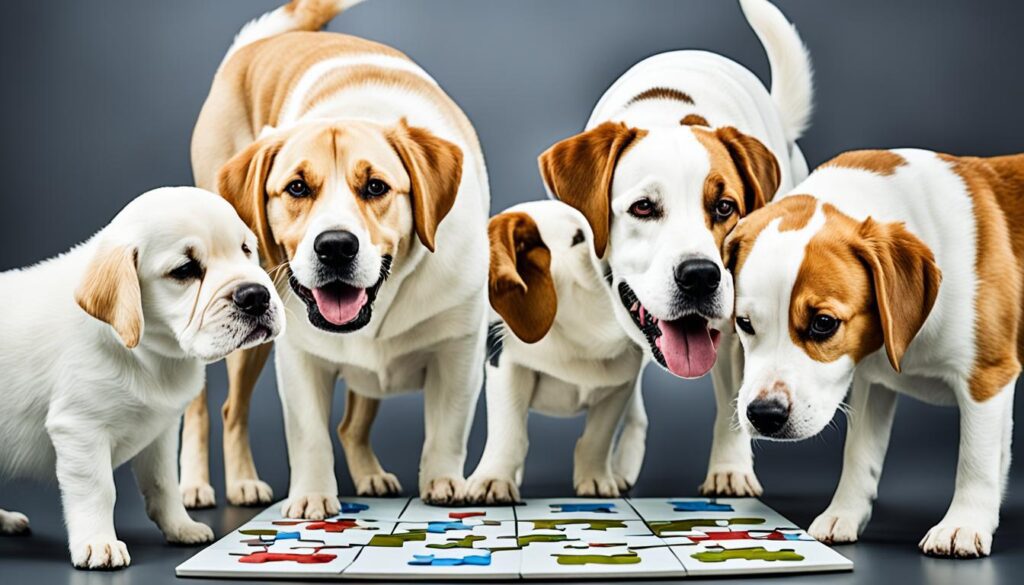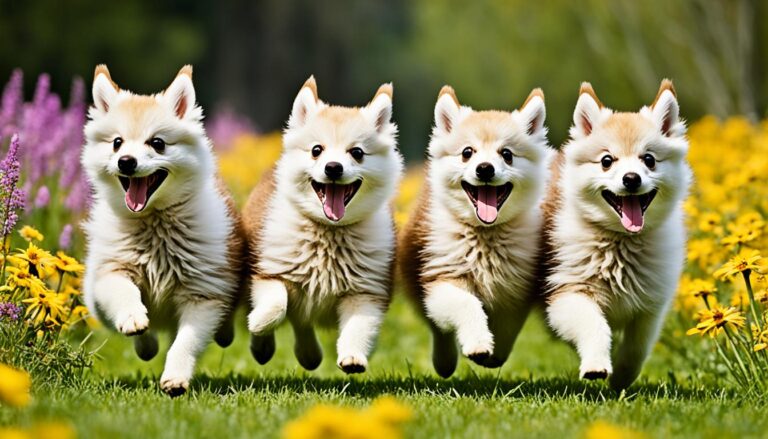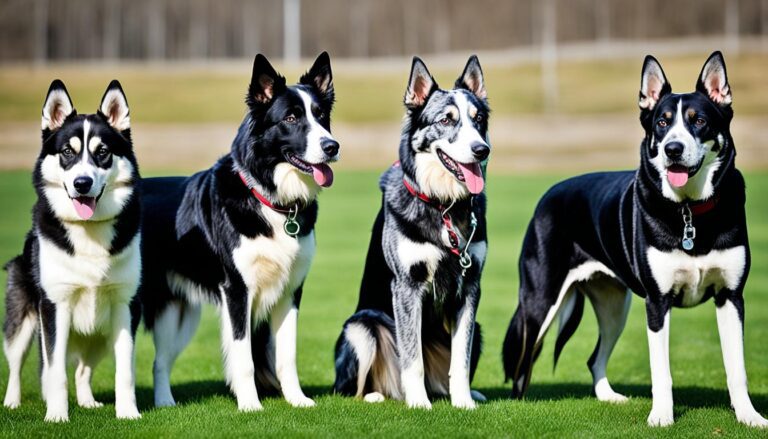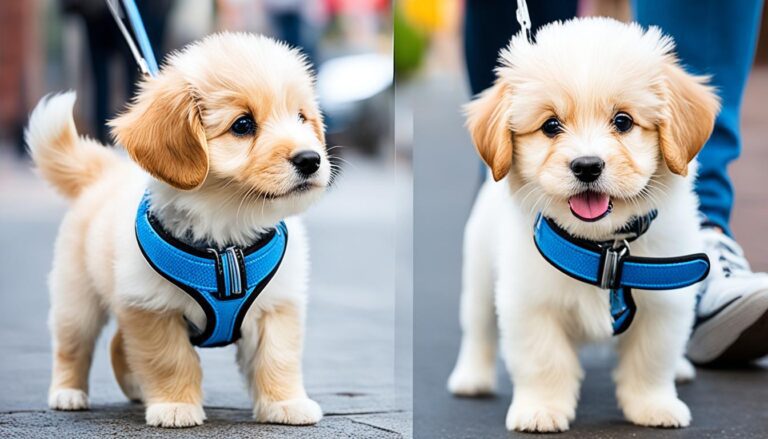Quiet Puppy Training Resources & Guides for Owners
Puppy training is an essential part of welcoming a new furry family member into your home. It’s important to provide your puppy with the right resources and guidance to ensure their training journey is calm and effective. By using quiet puppy training techniques, you can create a peaceful environment for both you and your puppy. In this section, we will explore various resources and guides that can help you in your quiet puppy training journey.
Key Takeaways
- Quiet puppy training is crucial for creating a peaceful environment.
- Explore various resources and guides to assist you with your puppy’s training.
- Focus on using calm and positive techniques to train your puppy.
- Consistency and patience are key in achieving successful puppy training.
- Always reward your puppy generously for their desired behavior.
Understanding How Dogs Learn and Solve Problems
Dogs are remarkable animals with the ability to solve problems and learn through trial and error. As responsible dog owners, it’s crucial to understand how dogs learn in order to effectively communicate with them during their training journey. By employing the right techniques, you can tap into their problem-solving skills and help them develop the desired behaviors.
One important aspect of understanding how dogs learn is recognizing that they are situational learners. This means that they can learn specific behaviors in one set of circumstances but may struggle to generalize those behaviors to slightly different situations. For example, your puppy may learn to sit on command at home but may have difficulty performing the same behavior at the park. Being aware of this situational learning can help you tailor your training approach accordingly.
Teaching your puppy what behaviors are acceptable and what behaviors will not solve their problem is essential. Dogs thrive on consistency, so it’s important to establish clear boundaries and expectations. By using positive reinforcement techniques such as praise, treats, or play, you can reward your puppy for exhibiting desired behaviors. This positive feedback helps them understand what behaviors are rewarding and encourages them to repeat those actions.
It’s also important to remember that each dog is unique and may respond differently to various training methods. Some dogs may be more motivated by food rewards, while others may prefer praise or play as their reinforcement. Understanding your dog’s preferences can help you determine the most effective training approach for them.
“Dogs are not our whole life, but they make our lives whole.” – Roger Caras
By taking the time to understand how dogs learn and solve problems, you can establish effective communication with your furry friend and guide them towards desired behaviors. Remember to be patient, consistent, and positive in your approach, and celebrate each small milestone your dog achieves in their training journey.

| Benefits of Understanding How Dogs Learn: | Effective Techniques to Enhance Learning: |
|---|---|
|
|
Puppy Training Priorities and Techniques
The first few months with a new puppy are crucial for their training and socialization. During this time, it is important to establish clear priorities and focus on essential techniques to set your puppy up for success. By addressing key areas such as socialization, house training, and basic skills, you can lay a solid foundation for your puppy’s future development.
1. Socialization
Socialization plays a vital role in shaping your puppy’s behavior and temperament. It involves exposing your puppy to various people, dogs, sounds, and experiences to help them develop confidence and adaptability.
“Socialization is a process that should begin as early as possible, ideally between 3 to 12 weeks of age. This critical period allows puppies to learn and accept new things with ease”
Take your puppy to different environments, such as parks, pet-friendly stores, and gatherings where they can interact with people and other animals. Gradually introduce them to various stimuli, such as different surfaces, noises, and objects. Supervision and positive reinforcement are crucial during these encounters to ensure a positive learning experience for your puppy.
2. House Training
Proper house training is a top priority when bringing a new puppy into your home. It involves teaching them where and when to eliminate and establishing a consistent routine.
Follow these house training tips:
- Designate a specific potty area outside and consistently take your puppy there after meals, naps, and playtime.
- Offer frequent opportunities for your puppy to relieve themselves, especially during the first few weeks.
- Use positive reinforcement, such as verbal praise or treats, when your puppy successfully eliminates in the appropriate area.
- Avoid punishment or scolding for accidents, as this may confuse or frighten your puppy.
3. Basic Skills
Teaching your puppy basic skills is essential for their safety, well-being, and your peace of mind. Start with foundational commands that will set the stage for more advanced training later on.
Here are some basic skills to focus on:
- Sit: Teach your puppy to sit on command, using treats and positive reinforcement.
- Come when called: Establish a reliable recall by starting in a quiet and low-distraction environment and rewarding your puppy for returning to you.
- Polite walking: Train your puppy to walk on a loose leash, rewarding them for walking beside you without pulling.
Consistency and patience are key when it comes to teaching basic skills. Keep your training sessions short and enjoyable, and always end on a positive note. Remember to reward your puppy generously for their efforts to create a positive association with training.
In this section, we explored the importance of prioritizing socialization, house training, and basic skills in your puppy’s early training. By focusing on these areas, you can help your puppy develop into a well-rounded and obedient companion. Next, we will delve into helpful tips for reducing excessive barking in dogs.
Tips for Reducing Excessive Barking
Excessive barking is a common issue that many dog owners face. Whether you have a dog or a puppy, it’s important to understand why they are barking excessively and find alternative ways for them to communicate. Simply yelling at your dog to be quiet is not an effective solution and may even escalate the problem.
Instead, try to identify the root cause of their barking. Is your dog barking out of fear, boredom, or frustration? Once you understand the underlying reason, you can address it appropriately. For example, if your dog barks at passersby outside the window, consider closing the curtains or moving them to another room where they can’t see the triggers.
Another effective method is to provide your dog with alternative forms of communication. Train them to use a specific signal or command to indicate their needs. For instance, if your dog barks when they want to go outside, teach them to ring a bell by the door to let you know. Consistency is key when implementing these alternative communication methods. Reward your dog with treats and praise when they use the desired form of communication instead of barking.
Remember, reducing excessive barking takes time and patience. It’s important to address the underlying cause, remove the motivation to bark, and provide alternative forms of communication. By doing so, you can create a calmer environment for both you and your furry friend.
FAQ
What is quiet puppy training?
Quiet puppy training is a method of training that focuses on creating a peaceful and calm environment for both the puppy and the owner. It involves using gentle techniques and positive reinforcement to teach the puppy desired behaviors while minimizing stress and anxiety.
What resources are available for quiet puppy training?
There are several resources available for quiet puppy training. You can find books, online guides, and videos that provide step-by-step instructions, tips, and techniques for effective and calm puppy training. Additionally, there are professional trainers who specialize in quiet puppy training and can offer personalized guidance.
Are there specific puppy training guides for quiet training?
Yes, there are dedicated puppy training guides that specifically focus on quiet training techniques. These guides provide detailed instructions on how to train your puppy in a calm and gentle manner, using positive reinforcement and minimizing stress. They often include helpful tips and troubleshooting advice to ensure successful training.
How can I ensure a calm training environment for my puppy?
To create a calm training environment for your puppy, it’s important to choose a quiet and distraction-free space where you can conduct training sessions. Minimize noise and other disturbances that could distract or startle your puppy. Also, establish a consistent routine and use positive reinforcement to reward desired behaviors, which will help promote a calm and focused training atmosphere.
What are some basic puppy training techniques?
Some basic puppy training techniques include teaching your puppy to sit, come when called, and walk politely on a leash. These skills are essential for building a strong foundation in your puppy’s training. Using positive reinforcement, such as treats or praise, can help motivate your puppy to learn and perform these behaviors.
How can I reduce excessive barking in my puppy?
Excessive barking can be addressed by understanding the underlying reasons for the behavior. Rather than yelling or scolding your puppy, try removing the motivation to bark and provide alternative forms of communication. For example, if your puppy barks at passersby, you can manage the behavior by closing curtains or using a white noise machine. Consistency and positive reinforcement can also help in reducing excessive barking.







